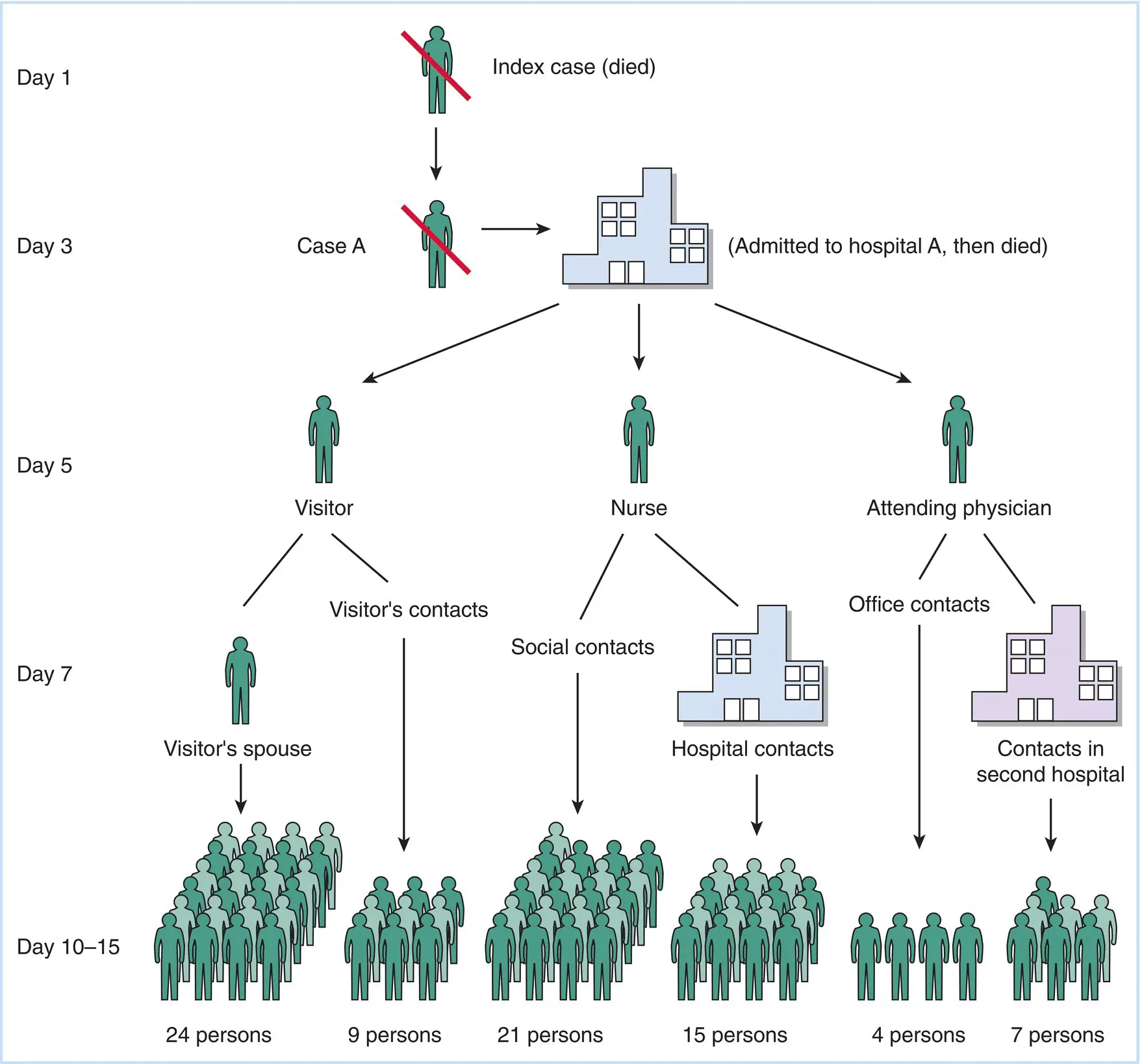A fictionalized sequence of events based on the Canadian SARS outbreak is shown schematically in Figure 3.3. Without the intervention of public health and other government agencies, the spread would continue through a susceptible population for an extended period of time. Further, it is clear that rapid recognition of symptoms and effective quarantine of affected individuals are key to stopping spread. In the case of SARS, the suppression of information concerning its appearance until it was potentially out of control in Asia could have led to a widespread epidemic there and in neighboring countries.
Many have suggested that only the lucky fact that the SARS coronavirus (SARS‐CoV) is not particularly efficient at spreading between individuals saved us from a much more serious situation. Further, it has been argued that SARS provided a testing ground for public health response strategies, which worked reasonably well. Other examples of serious virus epidemics have not had as felicitous outcomes – for example, the HIV epidemic, which continues to grow and consume increasingly significant public health resources. Several other potentially lethal epidemics threaten the human population in the future, including a strain of avian influenza, and another coronavirus that is related to SARS‐CoV, Middle East respiratory syndrome coronavirus (MERS‐CoV), which caused a similar severe respiratory disease in the Middle East and is transmitted to humans from camels. Finally, the emergence of SARS‐CoV‐2 in 2019 with its more efficient human‐human transmission (than SARS‐CoV) resulted in the world‐wide pandemic of COVID‐19.

Figure 3.3Fictionalized timeline of the spread of SARS virus following its introduction into Toronto, Canada, from Hong Kong in early 2003. Source: Data based on material presented on the CDC website ( http://www.cdc.gov/ncidod/sars) and in the February 2004 issue of the Journal of Emerging Infectious Diseases , which was dedicated to studies on the SARS outbreak of late 2002–early 2003.
General features of these diseases and the viruses that cause them will be discussed in Parts IIIand IV, and an overview of the potential threats of virus disease in the future will be briefly addressed in Part V. It suffices here to note that the dynamics of virus spread are not the problem; rather, it is coordinating political, public health, medical, and scientific resources targeted at the control of infection in a timely and efficient manner that is and will continue to be major challenges.
Factors affecting the control of viral disease in populations
Generation of lasting immunity provides an effective means of controlling and even eradicating certain viral diseases. The antigenic stability of the smallpox virus and effective immunity against it allowed effective vaccination programs to eradicate the disease from the population. Polio and measles are current candidates for partial or total elimination from the population due to availability of effective vaccines. In addition, currently a program is underway to try to vaccinate wild populations of raccoons and other small carnivores against rabies with use of vaccine‐laced bait. It is hoped that such an approach will reduce or eliminate the growing incidence of rabies in US wild animal populations. Of course, the reason for this solicitude has little to do with the animals involved; rather, it is to afford protection to domestic animals, and ultimately to humans.
Despite our considerable abilities, not all viral diseases can be readily controlled even under the most favorable economic and social conditions. Flu virus variants arise by genetic mixing of human and animal strains, and it is not practical to attempt a widespread vaccination campaign with so many variables. HIV remains associated with lymphatic tissue in infected individuals even when antiviral drugs effectively suppress virus replication. The intimate association of HIV with the immune system may make vaccination campaigns only partially effective. The ability of herpesviruses to establish latent infections and to reactivate suggests that a completely effective vaccine may be difficult if not impossible to generate.
A major obstacle to the control of viral and other infectious diseases in the human population as a whole is economic. It costs a lot of money to develop, produce, and deploy a vaccine. Many of the nations most at risk of deadly infectious disease outbreaks are financially unable to afford effective control measures, and pharmaceutical corporations involved with vaccine research and production are primarily interested in bottom‐line profit. Perhaps more tragically, some nations at risk also lack the political will and insight to mount effective efforts to counter the spread of viral disease. Such problems constantly change character but are never ending.
ANIMAL MODELS TO STUDY VIRAL PATHOGENESIS
The great German clinical microbiologist Robert Koch formulated a set of rules for demonstrating that a specific microorganism is the causative agent of a specific disease. These rules are very much in force today. In essence, Koch's rules are as follows:
1 The same pathogen must be able to be cultured from every individual displaying the symptoms of the disease in question.
2 The pathogen must be cultivated in pure form.
3 The pathogen must be able to cause the disease in question when inoculated into a suitable host.
While these rules can be applied (with caution ) to virus‐mediated human diseases, it is clearly not ethical to inoculate a human host with an agent suspected to cause a serious or life‐threatening disease (criterion 3). Regrettably, this ethical point has been missed more than once in the history of medicine. Examples of the excesses of uncontrolled human experimentation stand as a striking indictment of Nazi Germany, but excesses are not confined to totalitarian forms of government. The infamous Tuskegee syphilis studies are an example of a medical experiment gone wrong. These studies, ostensibly to evaluate new methods to treat syphilis, were carried out on a large group of infected African‐American men in the rural southern United States by physicians of the US Public Health Service in the 1930s and 1940s. Even though effective treatments were known, a number of men were treated with placebos(essentially sugar pills) to serve as “controls” and to allow the physicians to accumulate data on progression of the disease in untreated individuals. Other examples of potentially life‐threatening experiments in the United States with little effort to explain the dangers or potential benefits (the criteria for informed consent) using volunteer prisoners as test subjects are also well documented.
This discussion should not lead to the conclusion that it is never appropriate to use human subjects to study a disease or its therapy. Human experimentation (such as in clinical trials) is critical to ensuring treatment safety and effectiveness, but to do such studies in an ethical manner, the risks and benefits must be fully understood by all those involved.
One extremely effective way to obtain reliable data on the dynamics of disease and its course in an individual is to develop an accurate animal model. A researcher's need to experimentally test variable factors during infection in order to build a detailed molecular and physiological picture of the disease in question can only be accomplished with a well‐chosen model. The lack of a suitable animal model for a viral disease is almost always a great impediment to understanding its disease processes and developing treatments.
Читать дальше













